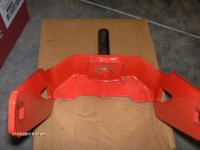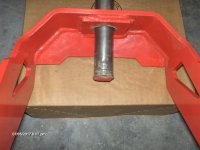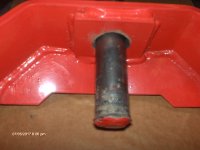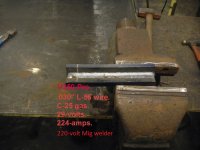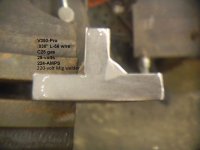You are using an out of date browser. It may not display this or other websites correctly.
You should upgrade or use an alternative browser.
You should upgrade or use an alternative browser.
weld failure?
- Thread starter lt190b
- Start date
/ weld failure?
#1
k0ua
Epic Contributor
Opinions are like ... and everyone has one. Here is mine.. It was never welded properly in the first place. It was welded with a MIG, and it wasn't turned up enough. Too much metal not enough heat to get really good penetration. Grind that off and stick weld it with some 7018 1/8 at at least 125 amps or more. If you can let the shaft down a little bit to get more of the rod to weld to and make it stronger with multiple passes. Like I said it is just an opinion. "there are many like it, but this one is mine". 
ArlyA
Super Member
- Joined
- Mar 18, 2016
- Messages
- 9,552
- Tractor
- Polaris Boss 6x6 with pods (tracks) Center actuating lawn mower by Husky
Not enough info. Could be either....
Rustyiron
Super Member
The part looks nearly unused, unless you scrubbed it clean for the pic. I agree with James assessment.
Shield Arc
Super Member
kthompson
Elite Member
- Joined
- Sep 12, 2008
- Messages
- 3,497
- Location
- South Carolina
- Tractor
- Kubotas B2710, M6800, L6060 cab, Volvo EC excavator, 2 ZTRs and various implements.
Man I was a welding inspector for a large heavy equipment company years ago and this sure brought back memories. From the picture I agree with the above post. I will also add to me it looks like the joint design did not allow for sufficient weld size for the load. Now all being said that is based upon what I see in the picture. Is there a reason the shaft is not welded on the other side of the metal it runs through?
Spanner
Veteran Member
Man I was a welding inspector for a large heavy equipment company years ago and this sure brought back memories. From the picture I agree with the above post. I will also add to me it looks like the joint design did not allow for sufficient weld size for the load. Now all being said that is based upon what I see in the picture. Is there a reason the shaft is not welded on the other side of the metal it runs through?
Seconded:
The part looks like a swiveling castor wheel support and they usually rotate around the round-bar post in a bushing which sits on the upper surface. Welding there causes an imperfect seating area and would not allow free rotation.
It's not a great fabrication but quite a common style of design in the grass industry.
A 'stepped' post would be a better design but more expensive to manufacture so the $ales Dept. wins over the Service Dept.
TMGT
Elite Member
In my opinion that's a poor design, weld could have been better but either way the design isn't adaquate. Either needs to be welded in two spaced places as was stated already or at least have a heavier "block" for the shaft and a press fit.
LD1
Epic Contributor
Its quite obvious that its a welding failure....the weld broke.
But the question is was the failure from abuse? Or a bad weld? or a Bad design? OR a combination of the above?
It dont matter how strong something is built, or how well it is welded, there is always someone who can tear it up.
I agree its a cheap design. But its probably on a cheap light duty cutter so what do you expect? Weld it back on and use it til it fails again. But good tailwheels ARE welded in two places. Usually the U shape fork has a second piece welded in about two inches below the top. The shaft goes through TWO pieces of metal and not just one.
Like
King Kutter Rotary Cutter Wheel Fork 4 19 by King Kutter Inc for $67.97 in King Kutter - Brands : Rural King
19 by King Kutter Inc for $67.97 in King Kutter - Brands : Rural King
or Wheel Fork | Agri Supply 63739
But the question is was the failure from abuse? Or a bad weld? or a Bad design? OR a combination of the above?
It dont matter how strong something is built, or how well it is welded, there is always someone who can tear it up.
I agree its a cheap design. But its probably on a cheap light duty cutter so what do you expect? Weld it back on and use it til it fails again. But good tailwheels ARE welded in two places. Usually the U shape fork has a second piece welded in about two inches below the top. The shaft goes through TWO pieces of metal and not just one.
Like
King Kutter Rotary Cutter Wheel Fork 4
or Wheel Fork | Agri Supply 63739
TMGT
Elite Member
I could be wrong but I first thought it was the front caster for a zero turn, looked like from a gravely . Maybe wrong but I doubt it was from a rotory cutter.
Now I'm kinda curious what it's off of.
Now I'm kinda curious what it's off of.
